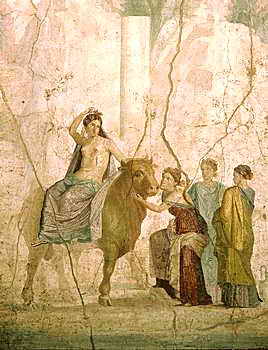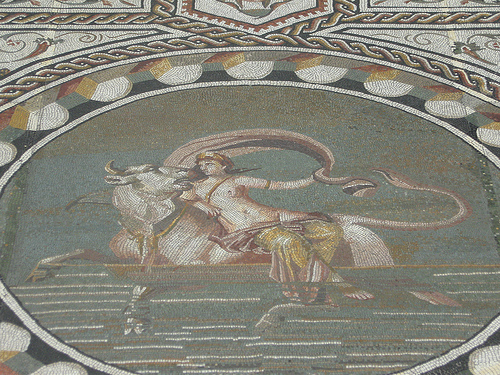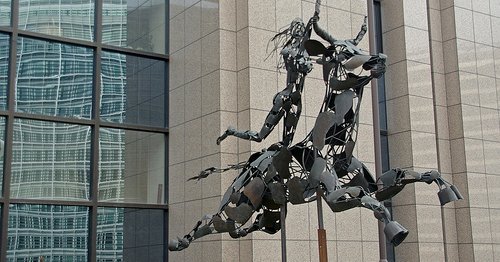Europa and Zeus: not a Shakespearian love story
The myth of Europa has inspired writers, historians, painters and European politicians throughout the centuries; they gave her name to a continent and created several pieces of art depicting the love making of Zeus and Europe. But let us first recall the most common version of this ancient legend. According to Greek mythology, the Phoenician maiden named ‘Europa’ was one of the many objects of affection of Olympian chief god Zeus. At first sight of Europa, the god was infatuated by her striking beauty and grace. Not being one to ignore his desires, Zeus immediately comes up with a cunning plan. In order to avoid the anger of his jealous wife Hera, and to get his way with the girl, Zeus metamorphosed in a beautiful white bull. While the young maiden was gathering flowers, she saw the bull, and – fascinated by its handsome flanks and gentle behavior - caressed him and got onto his back. Zeus took that opportunity to abduct Europa and swim to the island of Crete. He there revealed his true identity, raped and impregnated her. Europa gave birth to Minos, who would become king of Crete.

Europe’s core values and Zeus’ behavior: unlikely friends
Firstly, we should point out that the myth is not an official symbol of the European Union, like the flag, anthem or motto. However, the founding myth of Europa and the bull has frequently been alluded to in relation to the continent and by the modern European Union, and can thus be considered not only a piece of toponymy, but also as a semi-official symbol or supranational personification of the European region.
However, having recalled the myth, its relevance for the European Union of today does not seem logical. From the name of the myth, one would assume that it must have something to do with the naming of Europe – and therefore is important. The term ‘Europe’ was most probably used by the ancient Greeks to define the geographical areas west and north of Greece, and later on for the whole mainland that was separated from Africa (then known as Libya) and Asia, expanding from the Strait of Gibraltar to the Bosporus. But we do not know why the Greeks named the continent after one of Zeus’ lovers, although scholars have suggested various theories. One being as simple as that Zeus with Europa swam from present day Lebanon and Syria to the western island of Crete. We conclude that from the toponymist’s point of view, the prevalence of the story does not seem sufficiently justifiable.
Hence there must be a deeper symbolic relevance that explains its omnipresence in the European Union. But when we analyze the events that take place in this story, the significance of the myth for the European Union seems an even bigger mystery: isn’t the rape of Europa a strange story to symbolize the European Union? How can a tale of a Phoenician woman, unwillingly abducted and sexually assaulted by a rutting, unscrupulous deity be used as a symbol for a unique project of peace, prosperity and freedom in human history, being the voluntary integration of different nations into the European Union? To answer these questions one must take some creative thinking and room for interpretation into account.
Europe’s quest for a founding myth
To understand the significance of the bull myth, one must first understand what a myth is. A myth is an allegoric story; a figurative mode of representation containing meaning other than the literal. It communicates its message by many levels of symbolism. Moreover, a myth has the ability to survive centuries of storytelling, grow and evolve, and act as a vehicle of inspiration. When connected to a landscape (as it often is), it is able to convey various insights into and knowledge of that landscape.
The myth of Europa and the Bull seems to do this in terms of Europe: it is a significant and sexy image of Europe reinventing itself as the European Union. It appears to have been known to previous ages and cultures and is in the process of being rediscovered and worked with in our present times. This is for example what the Greek did with their coin: it uses the mythical kidnapping to symbolize modern Europe. The images on coins are not randomly chosen, they function as emblems of the country that mints them. The Euro was introduced in 2002 and marked a transition to a new Europe. At this moment of change, the picture on the Greek coin provides the reassurance of continuity: new Europe is still old Europe, with a long tradition that goes back to ancient Greece. Looking at these coins, it is hard not to be struck by the similarity of the iconography. Nor has its function changed: it is still used, as it was back then, to symbolize a region.

The myth has been paraded not only in Greece, but throughout the Union at particularly charged moments in European history. We should note that the image is more widespread than the myth and we may derive from this that to the EU the famous emblem is more important than the tale. With good reason, because when we alert to the narrative of the myth, the question remains: what does it mean for the EU? In mythology, a message is more constructed by its recipient than by its sender. Is the bull-god the President of the European Union, snatching Europa away towards an (unwanted?) economic en cultural unification? Does it say: joining the EU means were ‘shafted’? Is Europa a naïve, passive victim or an adventurous girl that takes the bull by the horns and seeks her destiny behind the horizon? Or does the bull represent the world that is madly in love with beautiful Europa? Well, maybe. It all depends on who is reading and what his or her attitude is towards the European Union.


1. On 11 March 2012 at 17:07, by Sophia Replying to: Europa and the bull: The significance of the myth in modern Europe
Replying to: Europa and the bull: The significance of the myth in modern Europe
This is the eternal story of the Virgin/Harlot who rides the beast.It is the tale of how Mary and other figures steals the spark or the essence of life and THEN runs away with it. She is the Beauty and he is Beast. She is the Heroine who kisses the Frog.She decapitates/truncates him and gets the seed.This is Eve. She travels to the Highest Heaven and tames theUNicorn.She is Sheba, or she is Salome,who after the7th veilor step can truncate him. Over the King is the Crown, and that is her - Sophia. She is the True Creator.
2. On 11 September 2012 at 09:31, by John Stanton Replying to: Europa and the bull: The significance of the myth in modern Europe
Replying to: Europa and the bull: The significance of the myth in modern Europe
She is the woman found in the book of Revelations, “”...and I saw a woman sit upon a scarlet coloured beast, full of names of blasphemy, having seven heads and ten horns." —Revelation 17:3
3. On 21 October 2013 at 13:23, by Gilles Gateau de Poisson Replying to: Europa and the bull: The significance of the myth in modern Europe
Replying to: Europa and the bull: The significance of the myth in modern Europe
Like all ancient Greek myths, it has many levels of meaning. But, in the context of the modern EU, it’s message is clear: an oligarchy, which presumes to a divine right, has duped the peoples of Europe into handing over their democratic rights. The upshot is a bull-headed monster which wanders the subterranean labyrinth, devouring tributes, until someone eventually summons up the nerve to slay the beast. What could be more apt?
4. On 26 October 2014 at 23:32, by Ronald Griffin Replying to: Europa and the bull: The significance of the myth in modern Europe
Replying to: Europa and the bull: The significance of the myth in modern Europe
I would like to say, that I am fascinated by all of the enlightening and intellectual comments, I agree with them all thank you!!
5. On 21 August 2015 at 10:59, by Dustin Replying to: Europa and the bull: The significance of the myth in modern Europe
Replying to: Europa and the bull: The significance of the myth in modern Europe
Id say it has a connection with Lillith, Adams first wife before Eve. She would be more plausable here riding Satan.. As she was the one who flew out of the garden to be away from Adam.
6. On 4 December 2015 at 09:26, by jes Replying to: Europa and the bull: The significance of the myth in modern Europe
Replying to: Europa and the bull: The significance of the myth in modern Europe
Hathor was the Egyptian Goddess of cows, as ancient as Isis or Aset, and her Sinai temple links her with the storm god of Syria. the antiquity of Europa to even ancient Greeks indicates a link to the time when the March Equinox fell in Taurus.
7. On 22 August 2022 at 14:50, by Robert Widdowson Replying to: Europa and the bull: The significance of the myth in modern Europe
Replying to: Europa and the bull: The significance of the myth in modern Europe
Very interesting perspective on the myth of Europa and Zeus. It is most bizarre that modern Europe still clings to this myth, since the myth contains at its centre such a disturbing scenario — the deception, abduction, and defilement of a woman by an all-powerful man. This is clearly beauty and the beast gone horribly wrong. Why the myth continues to please people is a question worth pondering!
Follow the comments: |
|
